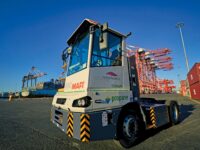Propane for Ports: Reduce Emissions and Increase Productivity Today

Every port provides unique value to the communities they serve, so port authorities are searching for cleaner, more resilient energy solutions for today and into the future while staying productive.
One of the best paths to decarbonization is transitioning to clean, reliable and available energy. Propane is a low emissions energy source providing the power and performance ports need for a variety of applications — everything from light- and mediumduty vehicles to forklifts, generators and port tractors. Best of all, propane is readily available to provide cleaner solutions that ports can implement today.
Propane Reduces Emissions
While diesel has been the mainstay of energy to ports for decades, powering large and small applications, its use produces significant amounts of pollution, including particulate matter (PM), nitrogen oxide (NOx) and carbon dioxide. These harmful emissions reduce air quality, increase incidence of respiratory issues, and leave port workers and communities at risk. Port authorities are moving away from dirty engines to make this diesel’s last decade, in favor of cleaner alternatives like propane. Depending on the application, propane produces virtually no PM emissions and can reduce NOx emissions by up to 96 percent compared to diesel.
In many applications, like medium-duty vehicles, forklifts and other cargo handling equipment (CHE), propane-powered equipment has a lower lifetime carbon footprint than comparable electric models. This is due to the amount of emissions produced in the manufacturing, transportation and disposal of electric batteries, as well as the generation and distribution of electricity, which often still comes from a coal or natural gas power plant.

Propane Powers CHE Today and Into the Future
Like many industries looking for clean energy options, port authorities have been feeling the push to “electrify everything.” However, it’s unrealistic to electrify all port operations due to the lack of infrastructure and technical limitations of electric CHE. In fact, on a quest to clean up port emissions, San Pedro Bay Port (SPBP) researchers recently analyzed the feasibility for systematic and rapid deployment of zero-emission and near-zero emission CHE by 2024. Using five criteria to analyze clean CHE — commercial availability, technical viability, operational feasibility, economic workability, and infrastructure and fuel availability — SPBP found only hybrids and internal combustion engines, powered by alternative energy sources like propane, met these needs.
Propane Increases Productivity
Not only is propane an affordable and readily available energy source, crews are able to keep downtime at a minimum with quick and easy refueling. Because it is portable, crews can also easily transport the energy source across the terminal to refuel CHE. Comparatively, battery life and power output for electric applications diminish over time which leads to costly upkeep. Not to mention, the downtime to charge the batteries creates added stress. Additionally, the study found electric options wasted considerable amounts of charge to move from the charging station to the work zone.
Propane offers the versatility to handle virtually every workload size without slowing down due to heavy loads. Operators can maintain productivity levels by simply filling up at an on-site refueling station, mobile refueling unit, or by swapping an empty cylinder for a full one.
As emissions from diesel applications continue to threaten port communities, port authorities can no longer wait to implement clean energy solutions. Propane is available now and will continue to be well into the future to offer the reliable, powerful and clean benefits electric options aren’t able to provide.
For more information about propane at ports, visit Propane.com/ports.
Editor’s Note: Seaports Magazine is proud to feature the voices of a wide variety of thought leaders who care deeply about ports and supply chain resilience, funding, and success. This and forthcoming articles like it solely express the sentiments of the writer and may not reflect the beliefs of the American Association of Port Authorities (AAPA) and its stakeholders or members.




